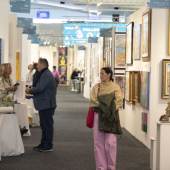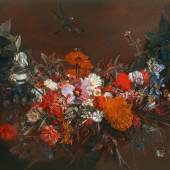The Women Who Dared to Paint: Sotheby’s Unveils
-
Auktion30.01.2019 - 01.02.2019
FEDE GALIZIA
Milan 1578 - 1630
Daughter of the miniaturist and painter, Nunzio Galizia, Fede Galizia trained under her father. Her precocious talent was already on full display as a young teenager, and by the age of 20, she had achieved international renown as a painter of portraits and devotional compositions. Although early modern female artists rarely received commissions for major history paintings, Galizia was best known in her lifetime for devotional works and commissioned portraits. While most 17th-century painters specialized in a single genre, she produced a diverse body of work – an especially unusual feat for a woman artist. While her still lifes were virtually unknown to scholars until the 20th century, it is now apparent that Galizia was one of the female artists who would play a vital role in the emergence of the relatively new genre of still life. Although she produced fewer than 20 refined, naturalistic still life compositions on panel, these works inspired followers in her lifetime and are now considered her most important paintings.
Fede Galizia’s A glass compote with peaches, jasmine flowers, quinces, and a grasshopper (estimate $2/3 million) is a beautiful example of the revolutionary female artist’s contributions to the Italian still life genre, which she helped to invent in the early 17th century. Exhibited internationally, the work was described as one of Galizia’s finest paintings in the second edition of Flavio Caroli’s definitive monograph of the artist’s work. Despite the intimate size of the panel, Galizia has created a sense of monumental scale with her placement of objects. Her close observation of details – such as the softness of the peaches, the modulations in the green on the leaves, and even the stripes on the grasshopper’s abdomen – continues to enchant viewers today.
GIULIA LAMA
Venice circa 1681 - 1747
Bold in her art, refined in her intellect, yet reserved in her nature, Giulia Lama is one of the most enigmatic and fascinating figures of Venice in the early 17th-century. As an artist, poetess, embroiderer and scholar, she transcended the boundaries placed upon women during her lifetime. Born in 1681 as the eldest of four children, she remained close to her family her whole life, never marrying and largely living a life of seclusion. She was lauded for her intelligence, and her skills as a poet were stylistically linked in style to Petrarch. Economically independent, she supported herself financially through her creative talents, including her fine lacework and paintings, which ranged from large and dramatic altarpieces to mythological scenes and sensitively executed portraits.
Unlike the Rococo style of her contemporary Rosalba Carriera, Giulia Lama executed large, energetic, and naturalistic compositions, often turning to subjects and techniques considered unconventional for women at the time. The present pair of canvases – which share a simple setting, restrained color palette, and a dramatic diagonal arrangement with each other – illustrates two lesser-known stories from the Old Testament: Joseph Interpreting the Eunuchs' Dreams and Eliphaz, Bildad and Zophar consoling Job (estimate $400/600,000). Untraced until recently, these two paintings serve as visual testaments to her unwavering character and artistic prowess that for many generations was overshadowed by her male contemporaries.
ANGELIKA KAUFFMANN
Coira 1741-1807 Rome
One of the most cultured and influential women of her generation, Angelika Kauffmann holds a place of particular importance in European art history. A talented musician, she was both a brilliant history and portrait painter. Born in Switzerland and trained in Rome, she first came to England in 1766. In London she quickly became a close friend of Sir Joshua Reynolds, who she is rumored to have nearly married at one point, as well as many of the most prominent cultural figures in England, including David Garrick. Fluent in English, French, Italian and German, her charm, wit, intelligence and skill attracted much attention. As a result, she was highly sought after as a portraitist by many of the foremost connoisseurs of the day – including members of the Royal family. In 1768, Kauffmann cemented her status by becoming one of only two female founding members of the Royal Academy. In her later years, following her marriage to the Italian decorative painter Antonio Zucchi, she returned to Rome where her studio became a popular stop for fashionable visitors on the Grand Tour, including artists, writers, aristocrats and dealers from across Europe. Her clients included many of the crowned heads of Europe, including Catherine the Great of Russia, and she was close friends with international luminaries such as Goethe, Canova and Sir William Hamilton.
One of the wealthiest families in England, the young generation of Spencers likely depicted in Angelika Kauffmann’s Portrait of Three Children were prominent figures in the English aristocracy, and amongst the artist’s earliest British patrons (estimate $600/800,000). Seated at left with a handful of flowers is Georgiana Spencer, later Duchess of Devonshire upon her marriage to William, 5th Duke of Devonshire in 1774. As Duchess, she became one of the most famous and powerful women in 18th-century British society. Her sister, Lady Henrietta Frances, later the Countess of Bessborough, is depicted at the center holding an arrow. To her right is George John, Viscount Althorp, later 2nd Earl Spencer, who would become a Member of Parliament for Northampton and later for Surrey.
-
12.04.2021 - 14.04.2021By Pak • 12- 14 April • A novel collection of digital art redefining our understanding...
-
20.04.2022ARTEXPO NEW YORK CELEBRATES ITS 45TH ANNUAL EDITION WITH A RENAISSANCE IN CONTEMPORARY AND FINE...
-
23.05.2018NEW YORK, 16 May 2018 – Today, Sotheby’s is honored to unveil the full contents of A...
-
Schließlich nimmt Rembrandts mit dem Amsterdamer Kunsthändler Hendrik van Uylenburgh...
-
30.01.2019 - 01.02.2019Auktion »
.




















